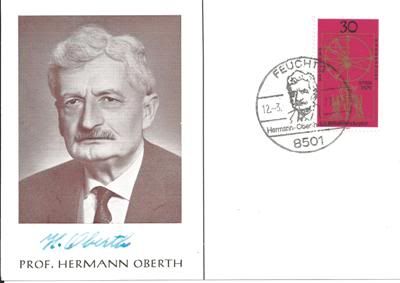Space Autograph of the Week Topic 6: Hermann OberthHermann Oberth was one of the most important pioneers of space technology. Oberth wrote several books in the 1920s that were the basis of scientific technology for space travel. The first, "The Rocket into Interplanetary Space" was written in 1923 and the second, "Ways to Travel in Space" was written in 1929. These books were visionary as they covered much of the future of space exploration from rockets and satellites, manned lunar exploration, space stations and space shuttles/ferries.

Oberth was born on June 25, 1894 in Hermannstadt (Transylvania), and died on December 28, 1989 in Nuremberg, Germany.
While still a youth Oberth was inspired by the science-fiction novels of Jules Verne and began designing his first rockets and performed medical experiments on himself that convinced him that humans could endure the physical stresses of space travel.
In 1928 and 1929 Oberth was a scientific consultant to the first "serious" space film. Do you know what it was? "Woman in the Moon" (German "Frau im Mond") is a science fiction silent film that premiered on October 15, 1929. It was written and directed by Fritz Lang, based on the novel "Die Frau im Mond" (1928, translated as "The Woman to the Moon" in 1930) by Thea von Harbou. It was released in the United States as "By Rocket to the Moon" and in the United Kingdom as "Woman in the Moon." The film presented the basics of rocket travel to a mass audience for the first time including the use of a multi-stage rocket - the moon rocket "Friede" was submerged in water before launch.
In the fall of 1929 Oberth fired his first liquid rocket engine, the "Kegeldüse". In these experiments he was supported by students of the Technical University of Berlin. One of them was Wernher von Braun, who would soon became technical director of the Army-Rocket-Test-Center in Berlin-Kummersdorf, and then in Peenemuende. The design of the first modern large rocket, the "A4", better known as the "V2", utilized 95 of Oberth's inventions and suggestions.
In the 1940s and 1950s Oberth produced many more publications giving him an appropriate title, the "Father of Space Travel".
From 1955 to 1959 he worked in Huntsville, Alabama under his former "student", Wernher von Braun, who was the technical director of NASA's Marshall Space Flight Center.
Oberth's suggestions for the application of the new space technology spanned imaging, communication and weather satellites, interplanetary satellites, manufacturing sites on the moon and planets, and space-stations in earth orbit
Wernher von Braun portrayed Oberth with the following words:
"Hermann Oberth was the first, who when thinking about the possibility of spaceships grabbed a slide-rule and presented mathematically analyzed concepts and designs...I, myself, owe to him not only the guiding-star of my life, but also my first contact with the theoretical and practical aspects of rocketry and space travel. A place of honor should be reserved in the history of science and technology for his ground-breaking contributions in the field of astronautics."
In appreciation of the contributions of Hermann Oberth, the "Hermann Oberth Society" in 1971 founded the "Hermann Oberth Space Museum" in Feucht, a small town near Nuremberg. Has anyone been able to visit the museum?












